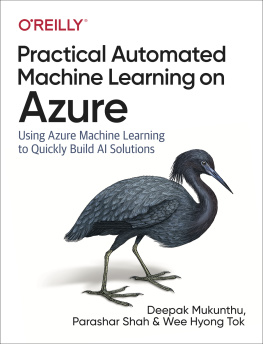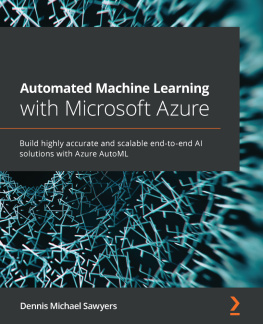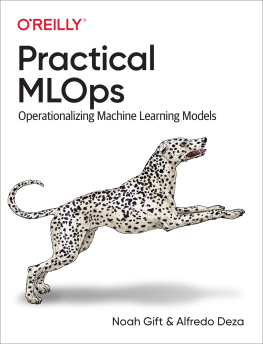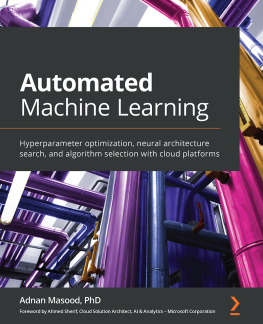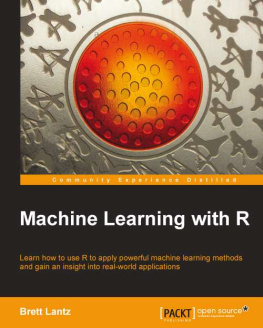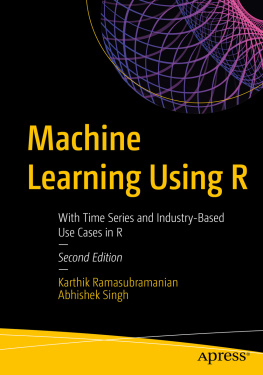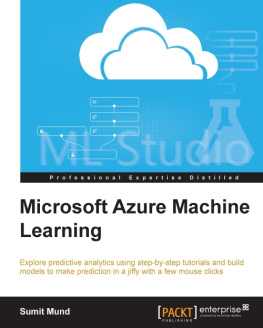Practical Automated Machine Learning on Azure
by Deepak Mukunthu , Parashar Shah , and Wee Hyong Tok
Copyright 2019 Deepak Mukunthu, Parashar Shah, and Wee Hyong Tok. All rights reserved.
Printed in the United States of America.
Published by OReilly Media, Inc. , 1005 Gravenstein Highway North, Sebastopol, CA 95472.
OReilly books may be purchased for educational, business, or sales promotional use. Online editions are also available for most titles (http://oreilly.com). For more information, contact our corporate/institutional sales department: 800-998-9938 or corporate@oreilly.com .
- Acquisitions Editor: Jonathan Hassell
- Development Editor: Nicole Tach
- Production Editor: Deborah Baker
- Copyeditor: Octal Publishing, LLC
- Proofreader: Sharon Wilkey
- Indexer: Judith McConville
- Interior Designer: David Futato
- Cover Designer: Karen Montgomery
- Illustrator: Rebecca Demarest
- September 2019: First Edition
Revision History for the First Edition
- 2019-09-20: First Release
See http://oreilly.com/catalog/errata.csp?isbn=9781492055594 for release details.
The OReilly logo is a registered trademark of OReilly Media, Inc. Practical Automated Machine Learning on Azure, the cover image, and related trade dress are trademarks of OReilly Media, Inc.
The views expressed in this work are those of the authors, and do not represent the publishers views. While the publisher and the authors have used good faith efforts to ensure that the information and instructions contained in this work are accurate, the publisher and the authors disclaim all responsibility for errors or omissions, including without limitation responsibility for damages resulting from the use of or reliance on this work. Use of the information and instructions contained in this work is at your own risk. If any code samples or other technology this work contains or describes is subject to open source licenses or the intellectual property rights of others, it is your responsibility to ensure that your use thereof complies with such licenses and/or rights.
978-1-492-05559-4
[LSI]
Dedications
Dedicated to my wife, kids, and parents for their unconditional love, encouragement and support in everything I do.
Deepak
Dedicated to the wonderful individuals in my lifeJuliet, Nathaniel, and Jayden. My gratitude and love for them is infinite.
Wee Hyong
I would like to thank my parents Nita and Mahendra and my sister Vidhi for their unconditional love and encouragement throughout my life. I am thankful to my buddies at MicrosoftPriya, Premal, Vicky, Martha, Savita, Deepti, and Sagarand my buddies outside of MicrosoftKevin, Ritu, Dhaval, Shamit, Priyadarshan, Pradip, and Nikhilfor their loving friendship.
Parashar
Foreword
I vividly remember my first undergraduate class in artificial intelligence (AI). My father had worked for years on expert systems, and I was at MIT to learn from the best how to perform this wizardry. Marvin Minsky, one of the founders of the field, even taught a series of guest lectures there. It was about midway through the semester when the great disillusionment hit me: Its all just a bunch of tricks! There was no intelligence to be found; just a bunch of brittle rules engines and clever use of math. This was in the early 90s and the start of my own personal AI winter, when I dismissed AI as not having much use.
Years later, while I was working on advertising systems, I finally saw that there was power in this bunch of tricks. Algorithms that had been hand-tuned for months by talented engineers were being beaten by simple models provided with lots of data. I saw that the explosion that was to come simply needed more data and more computation to be effective. Over the past 5 to 10 years, the explosion in both big data and computation power has unleashed an industry that has had lots of starts and stops to it.
This time is different. While the hype about AI is still tremendously high, the potential applications of practical AI have really just begun to hit the business world. The rules or people making predictions today will be replaced virtually every place by AI algorithms. The value AI creates for businesses is tremendous, from being better able to value the oil available in an oil field to better predicting the inventory a store should stock of each new sneaker. Even marginal improvements in these capabilities represent billions of dollars of value across businesses.
Were now in an age of AI implementation. Companies are working to find all the best places to deploy AI in their enterprises. One of the biggest challenges is matching the hype to reality. Half the companies Ive talked to expect AI to perform some kind of magic for problems they have no idea how to solve. The other half are underestimating the power that AI can have. What they need are people with enough background in AI to help them conceive of what is possible and apply it to their business problems.
Customers I talk to are struggling to find enough people with those skills. While they have lots of developers and data analysts who are skilled and comfortable making predictions and decisions with data, they need data scientists who can then build the model from that data. This book will help fill that gap.
It shows how automated ML can empower developers and data analysts to train AI models. It highlights a number of business cases where AI is a great fit to the business problem and show exactly how to build that model and put it into production. The technology and ideas in this book have been pressure-tested at scale with teams all across Microsoft, including Bing, Office, Azure Security, internal IT, and many more. Its also been used by many external businesses using Azure Machine Learning.
Eric Boyd
Microsoft Corporate Vice President, Azure AI
September 2019
Preface
Conventions Used in This Book
The following typographical conventions are used in this book:
ItalicIndicates new terms, URLs, email addresses, filenames, and file extensions.
Constant widthUsed for program listings, as well as within paragraphs to refer to program elements such as variable or function names, databases, data types, environment variables, statements, and keywords.
Constant width boldShows commands or other text that should be typed literally by the user.
Constant width italicShows text that should be replaced with user-supplied values or by values determined by context.
Tip
This element signifies a tip or suggestion.
Note
This element signifies a general note.
Warning
This element indicates a warning or caution.
Using Code Examples
Supplemental material (code examples, exercises, etc.) is available for download at https://oreil.ly/Practical_Automated_ML_on_Azure.
This book is here to help you get your job done. In general, if example code is offered with this book, you may use it in your programs and documentation. You do not need to contact us for permission unless youre reproducing a significant portion of the code. For example, writing a program that uses several chunks of code from this book does not require permission. Selling or distributing a CD-ROM of examples from OReilly books does require permission. Answering a question by citing this book and quoting example code does not require permission. Incorporating a significant amount of example code from this book into your products documentation does require permission.

